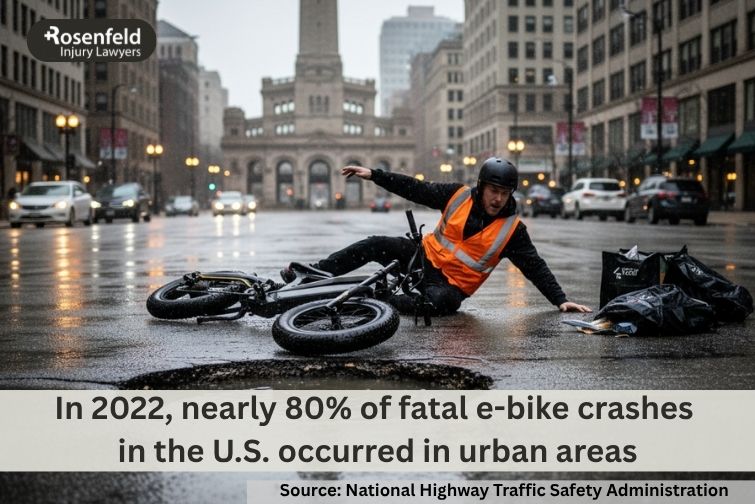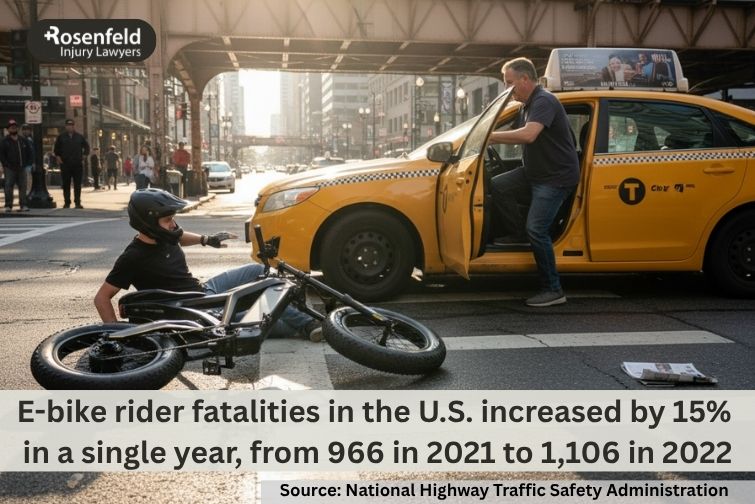Accident Lawyer
E-Bike Accident Statistics
As electric bicycles grow in popularity across Chicago, so too have reports of serious e-bike accidents and injuries. Recent e-bike accident statistics from national safety databases show a sharp rise in crashes involving micromobility vehicles, especially electric bikes, which can reach speeds of 20 to 28 mph and share crowded city streets with motor vehicles.
Our team at Chicago Bike Injury Lawyers represents injured e-bike riders throughout Cook County and beyond. We’ve seen firsthand how e-bike injuries can be far more severe than those from traditional bikes, often involving head trauma, internal injuries, and prolonged recovery times.
We stand with injured e-bike accident victims who are navigating the physical, emotional, and financial aftermath of a crash. Whether the incident involved a negligent driver, unsafe road design, or a defective electric bicycle, our e-bike accident law firm in Chicago is here to help you understand your rights and pursue accountability.

Consumer Product Safety Commission Report on E-Bike Fatalities
According to the U.S. Consumer Product Safety Commission (CPSC), e-bike accident statistics reveal a sharp and troubling rise in fatalities and injuries linked to electric bicycles between 2017 and 2023. The CPSC’s latest reporthighlights that e-bikes now account for the majority of micromobility device-related fatalities in the United States.
Total E-Bike Fatalities and Key Patterns
Over the seven-year reporting period, 193 people were killed in e-bike accidents, representing more than half (52%) of all micromobility fatalities recorded nationwide (373 total). These deaths occurred across all age groups and in a variety of scenarios, from motor vehicle collisions to battery fires and unknown falls.
The leading cause of death among e-bike users was motor vehicle accidents, which accounted for 113 fatalities (59%). In these cases, e-bike riders were struck by cars, trucks, or other motor vehicles, often while sharing traffic lanes or crossing intersections.
The second most common cause involved control issues, responsible for 31 electric bike fatalities. These incidents typically involved riders losing balance or colliding with fixed objects such as signs, gates, curbs, or barricades.
Battery fires were the third major hazard, with 14 fatalities attributed to lithium-ion battery malfunctions. Seven of these deaths occurred in bike shops or repair facilities where battery packs ignited, while two were caused by flame eruptions during charging, one when an e-bike fell into water, and four cases with no charging information available.
Additionally, ten fatalities involved pedestrian accidents: eight pedestrians were struck and killed by e-bikes, and two e-bike riders died after colliding with pedestrians. The CPSC also reported 22 fatal incidents categorized as falls of unknown origin, where investigators lacked sufficient evidence to determine the cause.
A small number of cases (two deaths) involved intoxicated riders, and one fatality resulted from a rider hitting a speed bump at high speed and crash-landing.
In total, these findings show that vehicle collisions and control issues were the top hazards associated with e-bike deaths. Of the 193 deaths, 14 were connected to eight separate lithium-ion battery-related fire incidents, a sobering reminder that product defects can be just as deadly as roadway crashes.
E-Bike Deaths by Age Group
The CPSC’s data show clear age-related risk patterns among e-bike users. Fatalities were most common among riders aged 25–44 (56 deaths) and 45–64 (51 deaths), followed closely by older adults aged 65 and over (49 deaths). These three groups together represent more than 80% of all electric bike fatalities nationwide.
By contrast, fatalities were rare among younger age groups:
- Under 5 years old: 0 deaths
- Ages 5–14: 4 deaths
- Ages 15–24: 17 deaths
The pattern suggests that adults and older riders, who often use electric bikes for commuting or recreation, are most at risk. Older riders (65+) accounted for nearly one-quarter of all electric bike fatalities, which may reflect both increased e-bike usage and greater vulnerability to severe injuries after a crash.

Gender Breakdown of Fatalities and Injuries
The CPSC recorded 157 male and 31 female fatalities, with five cases of unknown sex. Men accounted for 81% of e-bike deaths, a consistent trend across micromobility data showing that male riders are far more likely to be involved in fatal e-bike accidents.
Emergency department data mirror this imbalance: 78% of e-bike injury patients were male, compared to just 22% female. This may be linked to higher risk-taking behavior, commuting patterns, or greater e-bike usage among men.
Where E-Bike Injuries Occur
The NEISS (National Electronic Injury Surveillance System) data from CPSC’s report shows that most electric bicycle injuries happen on streets or highways (52%), underscoring the dangers of sharing space with motorists. Another 35% were classified as “not recorded,” often meaning outdoor or undefined crash sites. Only a small percentage occurred at home (2%), in other public places (8%), or at schools (<1%).
These figures emphasize that urban environments (not recreational spaces) pose the greatest danger to e-bike riders. For cities like Chicago, where bike lanes often intersect with busy traffic corridors, the need for better rider safety infrastructure is urgent.
Who Is Getting Hurt: Age and Race Distributions
E-bike injuries are concentrated among younger and middle-aged adults. Between 2017 and 2023, 35% of injured riders were ages 25–44, and 29% were 45–64. Only 10% of emergency department visits involved riders aged 65 and older, despite their overrepresentation in fatalities. Another 18% involved riders 15–24, while 8% of injuries occurred among children ages 5–14.
From a racial and ethnic standpoint, 59% of injured riders were White (non-Hispanic), followed by 28% Black or African American (non-Hispanic), 9% Hispanic (any race), and 4% other races or unknown. The data suggest that micromobility injuries increasingly affect diverse urban populations who rely on e-bikes as accessible and eco-friendly transportation.

Hospital Data and Injury Severity
Over the study period, emergency departments nationwide treated an estimated 87,400 electric bicycle-related injuries, accounting for roughly 19% of all micromobility injuries. Injury rates increased tenfold between 2017 and 2023, with 34,200 cases in 2023 alone. This rapid increase in emergency department visits mirrors the nationwide growth in e-bike use for commuting and recreation.
Injury severity was significantly higher for e-bikes than for regular bicycles or hoverboards, with more severe injuries, longer hospital stays, and higher rates of head trauma. Many injured e-bike riders required hospitalization for internal trauma, neck injuries, and orthopaedic fractures. The CPSC also noted that helmet use remains inconsistent, which contributes to the high number of head injuries and fatal injuries among riders.
Why E-Bike Crashes Are More Dangerous
The data clearly indicates that electric bicycles pose unique hazards compared to conventional bicycles. Because e-bikes travel at higher speeds (their top speed being 28 mph), riders experience greater impact forces in a crash. The presence of an electric motor also adds weight, making loss-of-control incidents more severe.
Furthermore, e-bikes travel farther and faster than regular bicycles, increasing exposure to traffic risks. The combination of speed, battery power, and shared traffic conditions has raised new safety concerns for riders and city planners alike.
What Are Common Injuries Sustained in E-Bike Accidents?
Research based on a nationally representative sample published in 2024 and covering data from 2021-2022 reveals that injured e-bike riders sustain a mix of orthopaedic injuries, head injuries, and internal trauma, many of which occur in collisions with motor vehicles or as a result of high-energy e-bike crashes.
Among all e-bike accident victims, the most frequent primary injury types were:
- Fractures: 26.9% of all electric bike injuries involved bone fractures, including the arm, wrist, collarbone, and leg.
- Contusions: 17.9% of riders suffered bruising or blunt-force trauma, typically from being thrown off the bike or struck by a vehicle.
- Internal injuries: 13.9% of victims experienced injuries to internal organs (most often in the chest or abdomen) consistent with the higher impact energy of electric bikes.
- Lacerations: 11.8% involved cuts and open wounds, often caused by contact with the ground, debris, or fixed objects during the crash.
- Strains and sprains: 6.3% were soft-tissue injuries affecting the back, shoulders, or limbs.
When analyzing the primary body parts injured, the report found:
- Head injuries were the most common, accounting for 18% of all e-bike injuries. Many involved head trauma or concussions, particularly among riders not wearing helmets.
- Facial injuries made up 12.5%, often caused by direct impact with the pavement or handlebars.
- Knee injuries accounted for 11.8%, while shoulder injuries and upper-trunk injuries each represented 9.2%.
Taken together, the data show that electric bike-related injuries most often affect the head, face, and limbs, and that fractures, internal trauma, and orthopaedic trauma make up the bulk of emergency-department visits.
Because e-bikes move faster and carry greater mass than regular bicycles, even minor loss of control or vehicle collisions can result in grave injuries to e-bike riders, including internal bleeding, broken bones, and soft-tissue trauma.
E-Scooter vs E-Bicycle Injuries
According to a national study comparing e-scooter injuries and e-bike injury statistics, e-bike riders tend to suffer more serious injuries than e-scooter users. Individuals injured while riding electric bikes were more likely to sustain internal injuries and require hospital admission, reflecting the greater impact force from faster speeds and frequent interactions with motor vehicles.
By contrast, powered scooter injuries were nearly three times more likely to result in a concussion (3% of scooter injuries vs 0.5% of electric bike injuries), suggesting that e-scooter crashes often involve low-speed falls and head injuries rather than deep internal trauma.
The study also found that electronic bike-related injuries were over three times more likely to involve a collision with a pedestrian than either pedal bicycles or powered scooters. Meanwhile, there was no evidence that scooters were more likely than bicycles to hit pedestrians.
Finally, researchers noted that while pedal bicycle injuries have declined (especially among children) electric bike injuries have increased sharply, particularly among older riders. This shift highlights the growing risk of devastating injuries for aging e-bike users as electric bikes travel faster and are used more widely on shared roadways.

E-Bicycle Safety Tips
Safety is one of the most important parts of riding e-bikes, especially as electric bikes continue to grow in popularity across busy city streets. Because e-bikes move at greater speeds and share the road with motor vehicles, proper preparation and caution can significantly reduce the risk of e-bike accidents and severe injuries.
While riders often choose electric bicycles for their convenience and environmental benefits, safe riding habits remain essential to reducing and preventing injury risks. The following e-bike safety tips can help keep riders protected from the most common micromobility-related injuries.
Wear a Helmet Every Time You Ride
Head injuries remain the leading cause of hospitalization after an e-bike accident. Wearing a properly fitted bicycle helmet dramatically lowers the risk of head trauma and fatal injuries, especially when crashes involve motor vehicles or stationary objects. Riders should choose helmets certified for high-speed micromobility vehicles to ensure full protection.
Follow Traffic Rules and Local Regulations
Under Illinois law, electric bicycles are treated similarly to traditional bicycles, meaning riders must obey the same traffic rules. Always ride with traffic, stop at red lights, and signal turns. Many electronic bike crashes occur when drivers misjudge an e-bike’s speed or when riders fail to follow predictable road patterns.
Check Your Equipment Before Every Ride
A quick inspection can prevent serious e-bike accidents. Test your brakes, tires, and electric assist system before heading out. A malfunctioning motor or low tire pressure can lead to loss of control. Riders should also ensure that the battery is secure and free from visible damage to avoid overheating or lithium-ion fires, which is a growing concern among consumer product-related injuries.
Be Visible to Motor Vehicles and Pedestrians
Most e-bike injuries happen in traffic, often because drivers don’t see the rider soon enough. Use a bright white front light and a red rear light, along with reflective gear, to stay visible from all directions. Extra lighting and reflective accessories can help prevent injuries related to collisions with motor vehicles and other micromobility injuries during low-light conditions.
Ride at Safe Speeds
While e-bikes offer the thrill of speed, traveling too fast as an inexperienced rider increases the risk of internal injuries, orthopaedic injuries, and head injuries in a crash. Adjust your speed to your surroundings: slow down in crowded areas, near intersections, and when approaching stationary objects such as poles or curbs.
Remember, the higher the speed, the greater the impact force and the risk of serious consequences.
Stay Alert and Avoid Distractions
Distracted riding is one of the leading causes of preventable electronic bike crashes. Keep both hands on the handlebars and your attention on the road. Avoid using headphones, phones, or other devices that take your focus away from traffic and surrounding conditions.
Maintain a Safe Distance from Motor Vehicles
Give yourself room to react. Many injured electronic bicycle riders are hurt in side-swipe or right-turn collisions. Keeping a safe buffer from passing traffic helps reduce the risk of being struck by motor vehicles or caught in their blind spots.
Use Caution with Batteries and Charging
Electric bicycles rely on lithium-ion batteries, which can pose risks if not maintained properly. Always use the manufacturer’s charger, avoid overcharging, and store the bike away from flammable materials. Poor battery maintenance can lead to overheating, fire hazards, or unexpected control issues during rides.
Watch for Pedestrians and Other Cyclists
Because e-bikes travel faster than traditional bicycles, riders have less time to react in crowded areas. Yield to pedestrians in crosswalks, use bells or signals when passing, and slow down when approaching sidewalks or intersections. Many e-bike-related injuries result from sudden movements in shared spaces, as well as from poor urban design, where narrow bike lanes and heavy traffic expose e-bike riders to greater danger

What Legal Options Do E-Bike Injury Victims Have in Illinois?
If you were injured while riding an electric bicycle, you may have the right to pursue compensation through civil claims under Illinois law. When an e-bike accident is caused by a motor vehicle, a defective product, or unsafe road conditions, the responsible party can be held legally accountable for your medical expenses, lost wages, and pain and suffering.
At Chicago Bike Injury Lawyers, we understand how devastating e-bike injuries can be. We stand with our clients as they recover from serious injuries and work to rebuild their lives. Our attorneys handle every aspect of the legal process, from investigating the crash and collecting evidence to negotiating fair settlements or pursuing litigation when necessary.
We offer a free consultation to discuss your case and explain your options. Our work is based on a contingency fee, meaning you pay no upfront costs and no attorney fees unless we recover compensation for you.
If you or someone you love has been hurt in an e-bike accident, you’re not alone. We believe in your case and are here to help you seek justice and move forward. Contact us today to learn more about how we can help.
Content reviewed by Chicago bicycle accident lawyer Jonathan Rosenfeld of Rosenfeld Injury Lawyers LLC, who holds negligent drivers, municipalities, and corporate defendants accountable to protect injured cyclists and their families, and is a trial lawyer recognized by National Trial Lawyers, Best Attorneys of America, and the National Association of Personal Injury Attorneys for high-severity injury claims.








